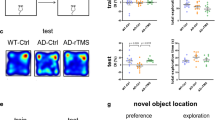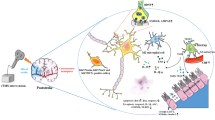Abstract
Repetitive transcranial magnetic stimulation (rTMS) is a non-invasive technique that could interfere cortical excitability though brief electric currents induced by alternating magnetic fields from the inductive coil. Currently, it has been applied in many fields of basic and clinical neuro-research. The aims of the present study are to investigate the effect of rTMS pre-treatment on cognitive function in vascular dementia (VaD) rats and further explore the molecular mechanism of rTMS neuroprotection on VaD. We found that rTMS pre-treated VaD rats showed significantly better memory and learning abilities in Morris water maze test compared to the untreated group. Moreover, the mRNA and protein expression levels of BDNF, TrkB, and SYN were significantly higher in the rTMS pre-treated group, indicating that rTMS pre-treatment has neuroprotective effect for VaD, which may have resulted from the increased level of BDNF, TrkB, and SYN in the hippocampal CA1 area.






Similar content being viewed by others
References
Akinyemi RO, Mukaetova-Ladinska EB, Attems J et al (2013) Vascular risk factors and neurodegeneration in ageing related dementias: Alzheimer’s disease and vascular dementia. Curr Alzheimer Res 10(6):642–653
Anderkova L, Rektorova I (2014) Cognitive effects of repetitive transcranial magnetic stimulation in patients with neurodegenerative diseases—clinician’s perspective. J Neurol Sci 339:15–25
Andero R, Choi DC, Ressler KJ (2014) BDNF-TrkB receptor regulation of distributed adult neural plasticity, memory formation, and psychiatric disorders. Prog Mol Biol Transl Sci 122:169–192
Furtado CP, Hoy KE, Maller JJ et al (2013) An investigation of medial temporal lobe changes and cognition following antidepressant response: a prospective rTMS study. Brain Stimul 6(3):346–354
Gedge L, Beaudoin A, Lazowski L et al (2012) Effects of electroconvulsive therapy and repetitive transcranial magnetic stimulation on serum brain-derived neurotrophic factor levels in patients with depression. Front Psychiatry 3:12
Guo W, Ji Y, Wang S, Sun Y et al (2014) Neuronal activity alters BDNF-TrkB signaling kinetics and downstream functions. J Cell Sci 127(Pt 10):2249–2260
Holtzheimer PE 3rd, McDonald WM, Mufti M et al (2010) Accelerated repetitive transcranial magnetic stimulation for treatment-resistant depression. Depress Anxiety 27(10):960–963
Iadecola C (2013) The pathobiology of vascular dementia. Neuron 80:844–866
Ikejima C, Yasuno F, Mizukami K et al (2009) Prevalence and causes of early-onset dementia in Japan: a population-based study. Stroke 40(8):2709–2714
Ljubisavljevic MR, Ismail FY, Filipovic S (2013) Transcranial magnetic stimulation of degenerating brain: a comparison of normal aging, Alzheimer’s, Parkinson’s and Huntington’s disease. Curr Alzheimer Res 10(6):578–596
Luo J, Zhang L, Ning N et al (2013) Neotrofin reverses the effects of chronic unpredictable mild stress on behavior via regulating BDNF, PSD-95 and synaptophysin expression in rat. Behav Brain Res 253:48–53
Ma J, Zhang Z, Su Y et al (2013) Magnetic stimulation modulates structural synaptic plasticity and regulates BDNF-TrkB signal pathway in cultured hippocampal neurons. Neurochem Int 62(1):84–91
Murdoch BE, Barwood CH (2013) Non-invasive brain stimulation: a new frontier in the treatment of neurogenic speech-language disorders. Int J Speech Lang Pathol 15(3):234–244
Nardone R, Tezzon F, Höller Y et al (2014) Transcranial magnetic stimulation (TMS)/repetitive TMS in mild cognitive impairment and Alzheimer’s disease. Acta Neurol Scand 129:351–366
Ni J, Ohta H, Matsumoto K et al (1994) Progressive cognitive impairment following chronic cerebral hypoperfusion induced by permanent occlusion of bilateral carotid arteries in rats. Brain Res 653:231–236
Ozkul A, Sair A, Akyol A et al (2014) Effects of lithium and lamotrigine on oxidative-nitrosative stress and spatial learning deficit after global cerebral ischemia. Neurochem Res 39(5):853–861
Srovnalova H, Marecek R, Kubikova R et al (2012) The role of the right dorsolateral prefrontal cortex in the Tower of London task performance: repetitive transcranial magnetic stimulation study in patients with Parkinson’s disease. Exp Brain Res 223(2):251–257
Tan T, Xie J, Liu T et al (2013) Low-frequency (1 Hz) repetitive transcranial magnetic stimulation (rTMS) reverses Aβ(1–42)-mediated memory deficits in rats. Exp Gerontol 48:786–794
Todd D, Gowers I, Dowler SJ et al (2014) A monoclonal antibody TrkB receptor agonist as a potential therapeutic for Huntington’s disease. PLoS One 9(2):e87923
Tongjaroenbuangam W, Ruksee N, Mahanam T et al (2013) Melatonin attenuates dexamethasone-induced spatial memory impairment and dexamethasone-induced reduction of synaptic protein expressions in the mouse brain. Neurochem Int 63(5):482–491
Wang F, Geng X, Tao HY et al (2010) The restoration after repetitive transcranial magnetic stimulation treatment on cognitive ability of vascular dementia rats and its impacts on synaptic plasticity in hippocampal CA1 area. J Mol Neurosci 41(1):145–155
Wang HY, Crupi D, Liu J et al (2011) Repetitive transcranial magnetic stimulation enhances BDNF-TrkB signaling in both brain and lymphocyte. J Neurosci 31(30):11044–11054
Acknowledgments
This work was supported by Chinese National Natural Science Foundation Grant (No. 81100805), Funding for the new century talents of General Hospital of Tianjin Medical University, Key project of Tianjin Research Program of Application Foundation and Advanced Technology (2015), and the Foundation of Key Laboratory of Genetic Engineering of the Ministry of Education (201302). The authors thank Feng Wang, Ph.D. for the critical review of the manuscript.
Author information
Authors and Affiliations
Corresponding authors
Rights and permissions
About this article
Cite this article
Wang, F., Chang, Gm., Yu, Q. et al. The Neuroprotection of Repetitive Transcranial Magnetic Stimulation Pre-treatment in Vascular Dementia Rats. J Mol Neurosci 56, 198–204 (2015). https://doi.org/10.1007/s12031-014-0480-7
Received:
Accepted:
Published:
Issue Date:
DOI: https://doi.org/10.1007/s12031-014-0480-7




